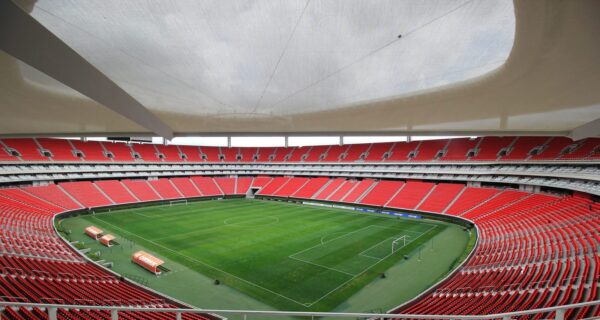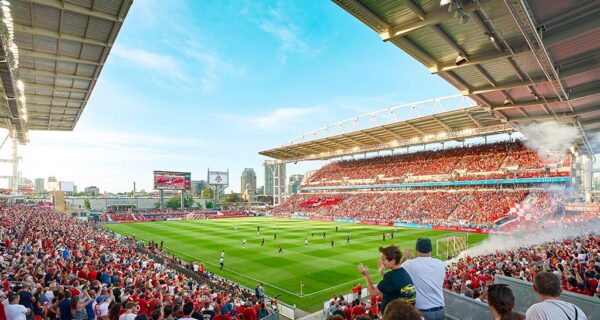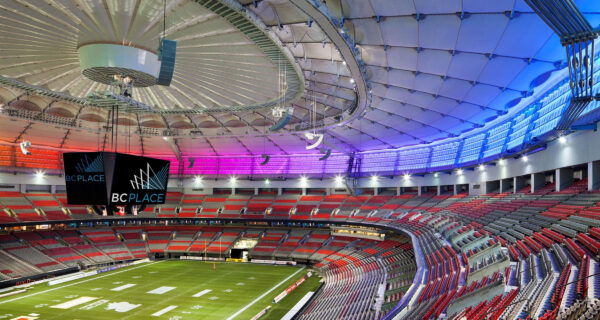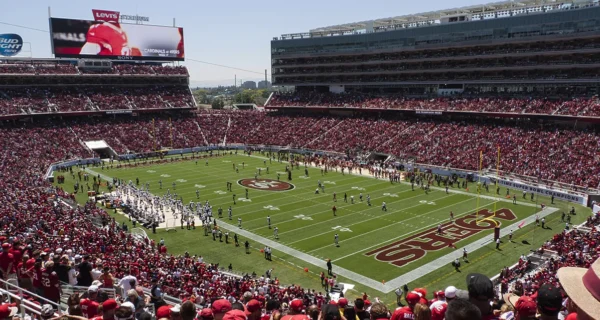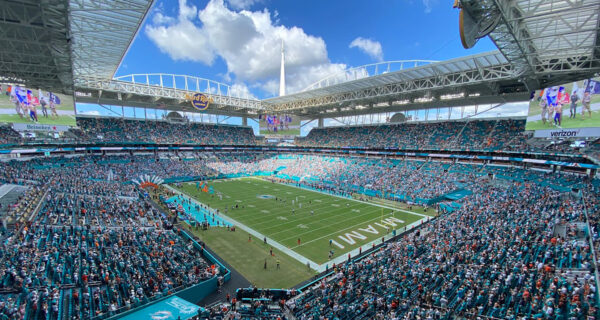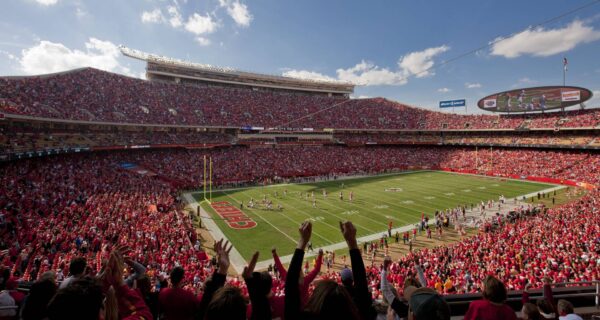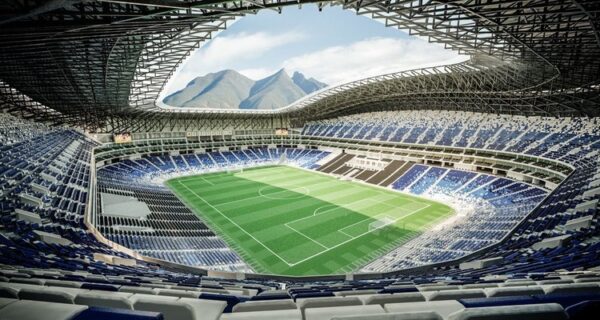MetLife Stadium stands as one of the most impressive sporting venues in the United States and is now stepping onto the global stage as the host of the 2026 FIFA World Cup final.
This magnificent stadium combines massive capacity with state-of-the-art facilities and excellent accessibility. Located in East Rutherford, New Jersey, this iconic venue serves as the home field for both the New York Giants and New York Jets of the National Football League (NFL).
The stadium has secured its place in soccer history as the chosen venue for the ultimate match of the 2026 FIFA World Cup, scheduled for July 19, 2026.
MetLife Stadium Overview
MetLife Stadium opened its doors on April 10, 2010, replacing the old Giants Stadium at the Meadowlands Sports Complex. The multi-purpose stadium hosts NFL games, international soccer matches, concerts, college football games, and other major events. Since its opening, the venue has welcomed over 600 major events and 3,000 special events, establishing itself as a premier destination for sports and entertainment.
The stadium is owned by the New Meadowlands Stadium Company, LLC, a joint venture between the New York Giants and New York Jets football teams. This partnership makes it one of only two NFL stadiums shared by two teams, creating a unique arrangement in professional sports. The neutral design allows the stadium to transition seamlessly between hosting Giants and Jets home games.
Location and Accessibility
Exact Location
MetLife Stadium is located at 1 MetLife Stadium Drive, East Rutherford, New Jersey, United States. It sits within the larger Meadowlands Sports Complex, approximately 5 miles (8 km) west of New York City. The stadium’s exact geographical coordinates are 40.813778 latitude and -74.074310 longitude.
The location offers proximity to the major metropolitan area of New York City without being directly within it, providing accessibility for fans from across the region. The stadium is positioned in Bergen County, New Jersey, and forms part of the New York metropolitan area, making it accessible to millions of potential visitors.
Transportation Options
Getting to MetLife Stadium is convenient thanks to multiple transportation options. The venue is accessible via the Meadowlands Rail Service, which operates for events with anticipated attendance above 50,000. This rail service delivers guests directly to the front door of the stadium.
Most of New Jersey’s transit rail system connects at the Frank R. Lautenberg Station at Secaucus Junction, allowing fans to quickly reach MetLife Stadium. The travel time between Secaucus Junction and the Sports Complex station is approximately 10 minutes. Rail service typically begins about 3.5 hours before an event and ends 1 hour after.
For those preferring bus transportation, Coach USA provides the 351 Meadowlands Express bus service from the Port Authority to the MetLife Sports Complex for NFL games and other large events. The service drops off and picks up passengers near Parking Lot K, with round-trip tickets costing $14.00 and one-way tickets at $7.00.
For drivers, parking is available at $40 per car, with lots opening 5 hours prior to events. For NFL games, guests must purchase parking permits in advance. The stadium also accommodates ride-sharing services like Uber and Lyft, with a designated Rideshare Zone located in Lot E off of West Peripheral Road, right outside of the Verizon Gate.
Stadium Capacity and Design
Seating Capacity
MetLife Stadium boasts an impressive capacity of 82,500, making it one of the largest stadiums in the NFL. This massive seating arrangement provides an electrifying atmosphere for sporting events and concerts alike. The stadium features over 10,000 premium seats and more than 200 luxury suites spread across four levels, offering varying levels of comfort and exclusivity.
The venue has hosted numerous record-breaking attendance events. During the 12th Siyum HaShas on August 1, 2012, the stadium welcomed 93,000 attendees, its highest attendance for any event.
For concerts, the record stands at 89,106 during Ed Sheeran’s +-=÷x Tour on June 11, 2023. The American football attendance record is 83,367 for the New York Jets vs. New York Giants game on October 29, 2023, and the soccer attendance record is 82,262 for Manchester United vs. Arsenal on July 22, 2023.
Design Features
MetLife Stadium features a distinctive design that allows it to serve as home to both the New York Giants and New York Jets. Unlike many dual-team stadiums that clearly favor one team in appearance, MetLife Stadium uses a neutral color scheme on non-game days. The aluminum façade louvres can be illuminated from inside to display team colors when games are played, indicating which team is hosting.
The stadium encompasses approximately 2.1 million square feet of space, providing ample room for concourses, concessions, clubs, and other amenities. The design prioritizes sightlines, ensuring that every seat offers a good view of the action on the field. The playing surface currently features FieldTurf Core HD, installed in 2023, replacing the previous UBU Speed S5-M surface that was in place from 2010 to 2022.
Screens and Displays
To enhance the fan experience, MetLife Stadium features four massive 30 ft × 118 ft (9.1 m × 36.0 m) video screens, one in each corner of the stadium. These high-definition displays allow fans to catch replays, statistics, and other content throughout events. Additionally, the stadium features a 360-degree ribbon board display that circles the interior, providing further information and entertainment.
These technological features ensure that no matter where fans are seated, they can stay connected to the action and enjoy an immersive experience. The combination of massive screens and state-of-the-art sound systems creates an engaging atmosphere for all types of events.
Amenities and Features
Seating Options
MetLife Stadium offers diverse seating options to accommodate different preferences and budgets. The stadium features over 10,000 club seats and more than 200 suites on four separate levels, with each suite accommodating 16-24 people. These premium areas provide enhanced comfort, exclusive amenities, and superior views of the action.
The stadium’s clubs include the EY Coaches Club, Corona Beach Club, Miller Lite MVP Club, Moody’s Commissioners Club, and the MetLife 50 Club. Each offers unique experiences and amenities for club seat holders and suite guests, including upscale food and beverage options, private restrooms, and comfortable seating areas.
Food and Beverage
MetLife Stadium partners with Delaware North Sportservice to provide a wide range of food and beverage options throughout the venue. Dozens of concession stands are available at all parts of the stadium, offering everything from traditional stadium fare to more gourmet and diverse culinary options.
The concessions are strategically placed throughout the concourses to minimize wait times and provide convenient access for all attendees. Premium areas feature enhanced menu options and service, adding to the exclusive experience for club seat holders and suite guests.
Second Floor Features
The second floor of MetLife Stadium offers a unique perspective of the action and numerous amenities that enhance the overall fan experience. This level includes premium seating areas with excellent views of the field, allowing fans to enjoy a more intimate experience alongside the energy of the larger crowd.
The spacious concourse on the second floor facilitates easy movement between sections and houses various food and beverage options. Fan engagement zones, interactive displays, and merchandise shops are also available, creating a lively atmosphere throughout events.
Viewing lounges on the second floor provide a more relaxed environment for fans to take breaks from the excitement, offering comfortable seating and great views of the action. For those seeking an elevated experience, hospitality suites on this level provide additional exclusivity and amenities.
FIFA World Cup 2026 at MetLife Stadium
The Final Match
MetLife Stadium has secured the prestigious honor of hosting the 2026 FIFA World Cup final, scheduled for July 19, 2026. This will be the culminating match of the 23rd edition of FIFA’s competition for men’s national football teams. FIFA announced the date of the final on March 16, 2023, and confirmed MetLife Stadium as the host venue on February 4, 2024.
During the tournament, FIFA will refer to the venue as “New York New Jersey Stadium” due to their sponsorship policies, which prevent the use of corporate names for tournament venues. The final match is expected to draw global attention, with billions of viewers tuning in worldwide and the stadium filled to capacity with passionate soccer fans.
Other World Cup Matches
Beyond the final, MetLife Stadium is scheduled to host 7 other matches during the 2026 FIFA World Cup. These additional matches will bring teams from around the world to East Rutherford, giving fans multiple opportunities to experience World Cup action at this premier venue.
The selection of MetLife Stadium for the World Cup final and other matches recognizes its world-class facilities and proven track record of hosting major soccer events. The stadium previously hosted the Copa América Centenario final in 2016, demonstrating its capability to accommodate international soccer at the highest level.
History and Construction
Construction Timeline
The journey of MetLife Stadium began on September 5, 2007, when ground was broken for construction. The building process spanned approximately two and a half years, with construction completed in 2010. The stadium officially opened on April 10, 2010, with its first event.
The new stadium was built adjacent to the almost 30-year-old Giants Stadium, which was demolished once the new facility was operational. This allowed for a seamless transition for both teams creating a state-of-the-art venue for fans to enjoy.
Cost and Architecture
With a price tag of $1.6 billion ($2.31 billion in 2024 dollars), MetLife Stadium was the world’s most expensive stadium when it opened in 2010. Despite initial hopes to include a roof, the ground was left uncovered due to funding constraints.
The architectural design was a collaborative effort involving several firms, including 360 Architecture, EwingCole, Rockwell Group, and Bruce Mau Design, Inc. Thornton Tomasetti served as the structural engineer, with Skanska as the general contractor. This team of experts created a facility that balances functionality, aesthetics, and fan experience.
FAQs
1. When will the FIFA World Cup final be held at MetLife Stadium?
The FIFA World Cup final is scheduled to take place at MetLife Stadium on July 19, 2026. This highly anticipated match will be the culminating event of the 23rd edition of FIFA’s men’s national football team competition, bringing teams and fans from around the world to East Rutherford, New Jersey.
2. What is the seating capacity of MetLife Stadium?
MetLife Stadium has a seating capacity of 82,500 for football and soccer events, making it one of the largest stadiums in the NFL. The venue can accommodate approximately 50,000 attendees for most concert configurations. The stadium’s record attendance was 93,000 during the 12th Siyum HaShas on August 1, 2012.
3. How do I get to MetLife Stadium using public transportation?
You can reach MetLife Stadium via the Meadowlands Rail Service, which operates for events with attendance above 50,000. Most of NJ Transit’s rail system connects at Secaucus Junction, with a 10-minute ride to the stadium. Alternatively, Coach USA provides the 351 Meadowlands Express bus service from Port Authority in New York City for $14 round-trip.
4. What NFL teams call MetLife Stadium home?
MetLife Stadium serves as the home field for both the New York Giants and the New York Jets of the National Football League (NFL). This dual-tenant arrangement makes it one of only two NFL stadiums shared by two teams, creating a unique situation in professional sports where the stadium hosts approximately 20 NFL games each regular season.
5. How much did it cost to build MetLife Stadium?
MetLife Stadium cost approximately $1.6 billion to construct ($2.31 billion in 2024 dollars), making it the world’s most expensive stadium when it opened in 2010. Despite being formally in public ownership, the stadium was financed primarily by its two main tenants – the NFL’s New York Jets and New York Giants.
6. What special features does the second floor of MetLife Stadium offer?
The second floor of MetLife Stadium features premium seating areas, spacious concourses with various food and beverage options, fan engagement zones, interactive displays, and merchandise shops. It also houses viewing lounges for a more relaxed environment and hospitality suites for those seeking an elevated game-day experience.
7. What other major events has MetLife Stadium hosted besides NFL games?
MetLife Stadium has hosted numerous high-profile events, including Super Bowl XLVIII in 2014, WrestleMania 29 and 35, the Copa America Centenario Final in 2016, the 2021 Army-Navy Game, and countless concerts. The venue has welcomed international soccer matches and will host the FIFA Club World Cup final in 2025.
8. What transportation options are available for getting to MetLife Stadium?
Visitors can reach MetLife Stadium via NJ Transit’s Meadowlands Rail Service, Coach USA’s 351 Meadowlands Express bus service, personal vehicles with pre-purchased parking permits ($40 per car), or ride-sharing services like Uber and Lyft, which have a designated pickup and drop-off zone in Lot E near the Verizon Gate.
9. How did MetLife Stadium get its name?
The stadium opened in 2010 as New Meadowlands Stadium but secured a naming rights partnership with MetLife insurance company in 2011. The deal runs until 2036, though during the 2026 FIFA World Cup, the venue will be called “New York New Jersey Stadium” due to FIFA’s sponsorship policies that prevent the use of corporate names.
10. What sustainability initiatives has MetLife Stadium implemented?
In 2021, MetLife Stadium became the first NFL stadium to join the UN Framework Convention on Climate Change’s Sports for Climate Action Framework. The stadium incorporates various sustainable practices, including energy efficiency measures, waste reduction initiatives, and water conservation efforts to minimize its environmental impact.








